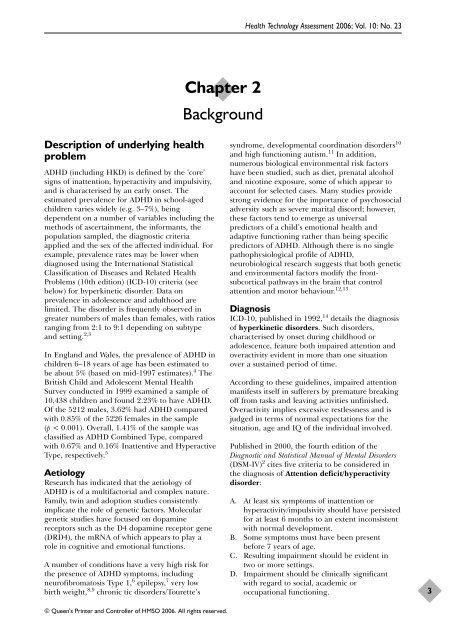A systematic review and economic model of the effectiveness and ...
A systematic review and economic model of the effectiveness and ...
A systematic review and economic model of the effectiveness and ...
You also want an ePaper? Increase the reach of your titles
YUMPU automatically turns print PDFs into web optimized ePapers that Google loves.
Description <strong>of</strong> underlying health<br />
problem<br />
ADHD (including HKD) is defined by <strong>the</strong> ‘core’<br />
signs <strong>of</strong> inattention, hyperactivity <strong>and</strong> impulsivity,<br />
<strong>and</strong> is characterised by an early onset. The<br />
estimated prevalence for ADHD in school-aged<br />
children varies widely (e.g. 3–7%), being<br />
dependent on a number <strong>of</strong> variables including <strong>the</strong><br />
methods <strong>of</strong> ascertainment, <strong>the</strong> informants, <strong>the</strong><br />
population sampled, <strong>the</strong> diagnostic criteria<br />
applied <strong>and</strong> <strong>the</strong> sex <strong>of</strong> <strong>the</strong> affected individual. For<br />
example, prevalence rates may be lower when<br />
diagnosed using <strong>the</strong> International Statistical<br />
Classification <strong>of</strong> Diseases <strong>and</strong> Related Health<br />
Problems (10th edition) (ICD-10) criteria (see<br />
below) for hyperkinetic disorder. Data on<br />
prevalence in adolescence <strong>and</strong> adulthood are<br />
limited. The disorder is frequently observed in<br />
greater numbers <strong>of</strong> males than females, with ratios<br />
ranging from 2:1 to 9:1 depending on subtype<br />
<strong>and</strong> setting. 2,3<br />
In Engl<strong>and</strong> <strong>and</strong> Wales, <strong>the</strong> prevalence <strong>of</strong> ADHD in<br />
children 6–18 years <strong>of</strong> age has been estimated to<br />
be about 5% (based on mid-1997 estimates). 4 The<br />
British Child <strong>and</strong> Adolescent Mental Health<br />
Survey conducted in 1999 examined a sample <strong>of</strong><br />
10,438 children <strong>and</strong> found 2.23% to have ADHD.<br />
Of <strong>the</strong> 5212 males, 3.62% had ADHD compared<br />
with 0.85% <strong>of</strong> <strong>the</strong> 5226 females in <strong>the</strong> sample<br />
(p < 0.001). Overall, 1.41% <strong>of</strong> <strong>the</strong> sample was<br />
classified as ADHD Combined Type, compared<br />
with 0.67% <strong>and</strong> 0.16% Inattentive <strong>and</strong> Hyperactive<br />
Type, respectively. 5<br />
Aetiology<br />
Research has indicated that <strong>the</strong> aetiology <strong>of</strong><br />
ADHD is <strong>of</strong> a multifactorial <strong>and</strong> complex nature.<br />
Family, twin <strong>and</strong> adoption studies consistently<br />
implicate <strong>the</strong> role <strong>of</strong> genetic factors. Molecular<br />
genetic studies have focused on dopamine<br />
receptors such as <strong>the</strong> D4 dopamine receptor gene<br />
(DRD4), <strong>the</strong> mRNA <strong>of</strong> which appears to play a<br />
role in cognitive <strong>and</strong> emotional functions.<br />
A number <strong>of</strong> conditions have a very high risk for<br />
<strong>the</strong> presence <strong>of</strong> ADHD symptoms, including<br />
neur<strong>of</strong>ibromatosis Type 1, 6 epilepsy, 7 very low<br />
birth weight, 8,9 chronic tic disorders/Tourette’s<br />
Chapter 2<br />
Background<br />
© Queen’s Printer <strong>and</strong> Controller <strong>of</strong> HMSO 2006. All rights reserved.<br />
Health Technology Assessment 2006; Vol. 10: No. 23<br />
syndrome, developmental coordination disorders 10<br />
<strong>and</strong> high functioning autism. 11 In addition,<br />
numerous biological environmental risk factors<br />
have been studied, such as diet, prenatal alcohol<br />
<strong>and</strong> nicotine exposure, some <strong>of</strong> which appear to<br />
account for selected cases. Many studies provide<br />
strong evidence for <strong>the</strong> importance <strong>of</strong> psychosocial<br />
adversity such as severe marital discord; however,<br />
<strong>the</strong>se factors tend to emerge as universal<br />
predictors <strong>of</strong> a child’s emotional health <strong>and</strong><br />
adaptive functioning ra<strong>the</strong>r than being specific<br />
predictors <strong>of</strong> ADHD. Although <strong>the</strong>re is no single<br />
pathophysiological pr<strong>of</strong>ile <strong>of</strong> ADHD,<br />
neurobiological research suggests that both genetic<br />
<strong>and</strong> environmental factors modify <strong>the</strong> frontsubcortical<br />
pathways in <strong>the</strong> brain that control<br />
attention <strong>and</strong> motor behaviour. 12,13<br />
Diagnosis<br />
ICD-10, published in 1992, 14 details <strong>the</strong> diagnosis<br />
<strong>of</strong> hyperkinetic disorders. Such disorders,<br />
characterised by onset during childhood or<br />
adolescence, feature both impaired attention <strong>and</strong><br />
overactivity evident in more than one situation<br />
over a sustained period <strong>of</strong> time.<br />
According to <strong>the</strong>se guidelines, impaired attention<br />
manifests itself in sufferers by premature breaking<br />
<strong>of</strong>f from tasks <strong>and</strong> leaving activities unfinished.<br />
Overactivity implies excessive restlessness <strong>and</strong> is<br />
judged in terms <strong>of</strong> normal expectations for <strong>the</strong><br />
situation, age <strong>and</strong> IQ <strong>of</strong> <strong>the</strong> individual involved.<br />
Published in 2000, <strong>the</strong> fourth edition <strong>of</strong> <strong>the</strong><br />
Diagnostic <strong>and</strong> Statistical Manual <strong>of</strong> Mental Disorders<br />
(DSM-IV) 2 cites five criteria to be considered in<br />
<strong>the</strong> diagnosis <strong>of</strong> Attention deficit/hyperactivity<br />
disorder:<br />
A. At least six symptoms <strong>of</strong> inattention or<br />
hyperactivity/impulsivity should have persisted<br />
for at least 6 months to an extent inconsistent<br />
with normal development.<br />
B. Some symptoms must have been present<br />
before 7 years <strong>of</strong> age.<br />
C. Resulting impairment should be evident in<br />
two or more settings.<br />
D. Impairment should be clinically significant<br />
with regard to social, academic or<br />
occupational functioning.<br />
3
















